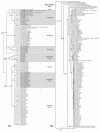The lesser of two weevils: molecular-genetics of pest palm weevil populations confirm Rhynchophorus vulneratus (Panzer 1798) as a valid species distinct from R. ferrugineus (Olivier 1790), and reveal the global extent of both
- PMID: 24143263
- PMCID: PMC3797061
- DOI: 10.1371/journal.pone.0078379
The lesser of two weevils: molecular-genetics of pest palm weevil populations confirm Rhynchophorus vulneratus (Panzer 1798) as a valid species distinct from R. ferrugineus (Olivier 1790), and reveal the global extent of both
Abstract
The red palm weevil (RPW) is a major pest of palms. It is native to southeast Asia and Melanesia, but in recent decades has vastly expanded its range as the result of multiple accidental anthropogenic introductions into the Middle East, Mediterranean Basin, Caribbean, and U.S.A. Currently regarded as a single species, Rhynchophorus ferrugineus (Olivier), RPW displays remarkable color variation across its range, and consequently has a taxonomic history littered with new species descriptions and synonymization. We compared DNA sequences of the mitochondrial cytochrome oxidase subunit I (COI) gene from RPW populations throughout the native and invaded ranges, to investigate the specific status and invasion history of this serious economic pest, and to identify possible common routes of entry. Analyses of COI haplotype data provide conclusive support, corroborated by sequences of additional nuclear gene regions, for the existence of at least two predominantly allopatric species. The true R. ferrugineus is native only to the northern and western parts of continental southeast Asia, Sri Lanka and the Philippines, and is responsible for almost all invasive populations worldwide. In contrast, the second species, which is currently synonymized under R. ferrugineus and should be resurrected under the name R. vulneratus (Panzer), has a more southern distribution across Indonesia, and is responsible for only one invasive population; that in California, U.S.A. The distribution of COI haplotypes is used to discuss the possible existence of further cryptic species, sources and routes of entry of different invasive populations, and the implications of our findings for current control methods.
Conflict of interest statement
Figures





References
-
- Wattanapongsiri A (1966) A revision of the genera Rhynchophorus and Dynamis (Coleoptera: Curculionidae). Dep Agric Science Bulletins 1: 1-328.
-
- Faleiro JR (2006) A review on the issues and management of red palm weevil Rhynchophorus ferrugineus (Coleoptera: Rhynchophoridae) in coconut and date palm during the last one hundred years. Int J Trop Insect Sci 26: 135-154.
-
- El-Mergawy RAAM, Al-Ajlan AM (2011) Red Palm Weevil, Rhynchophorus ferrugineus (Olivier): Economic Importance, Biology, Biogeography and Integrated Pest Management. J Agric Sci Technol A 1: 1-23.
-
- Molet T, Roda AL, Jackson LD (2011) CPHST Pest Datasheet for Rhynchophorus ferrugineus. USDA-APHIS-PPQ-CPHST.
-
- NAPPO (2010) First U.S. detection of the Red Palm Weevil, Rhynchophorus ferrugineus, in California. Available: http://www.pestalert.org/oprDetail.cfm?oprID=468. Accessed 27th December 2012.
Publication types
MeSH terms
LinkOut - more resources
Full Text Sources
Other Literature Sources
Molecular Biology Databases

